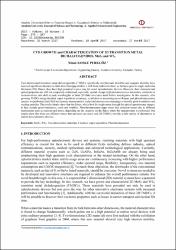| dc.contributor.author | Perkgöz, Nihan Kosku | |
| dc.date.accessioned | 2019-10-21T20:41:28Z | |
| dc.date.available | 2019-10-21T20:41:28Z | |
| dc.date.issued | 2017 | |
| dc.identifier.issn | 1302-3160 | |
| dc.identifier.uri | http://www.trdizin.gov.tr/publication/paper/detail/TWpRMU56VXhNUT09 | |
| dc.identifier.uri | https://hdl.handle.net/11421/20799 | |
| dc.description.abstract | Two-dimensional transition metal dichalcogenides (TMDC), specifically molybdenum disulfide and tungsten disulfide have received significant attention as their direct bandgap exhibits a shift from indirect to direct as the layer goes to single molecular thickness (2D). Hence, they have high potential to pave way for novel optoelectronic devices. However, their structural and optical properties are still not completely understood, especially, spatial change of photoluminescence intensities, variations in excitons-trions, and shift in peak wavelengths in these 2D flake structures need further investigation. In this research, after growing TMDCs using chemical vapor deposition technique, in addition to measuring micro Raman and photoluminescence spectra, we performed dark field microscopy measurements and photoluminescence mappings to identify grain boundaries and seeding particles. The results clearly show that the flakes, which look lie single-piece through the optical spectroscopy images, in fact, include grain boundaries, seeds and wrinkles. Photoluminescence maps reveal that emission occurs due to different mechanisms such as excitons and trions, depending on the locations on the flakes where the measurement is performed. Our results show that there are different routes that emission can occur and 2D TMDCs provide a rich variety of alternatives to realize novel photonic devices. | en_US |
| dc.description.abstract | Two-dimensional transition metal dichalcogenides (TMDC), specifically molybdenum disulfide and tungsten disulfide have received significant attention as their direct bandgap exhibits a shift from indirect to direct as the layer goes to single molecular thickness (2D). Hence, they have high potential to pave way for novel optoelectronic devices. However, their structural and optical properties are still not completely understood, especially, spatial change of photoluminescence intensities, variations in excitons-trions, and shift in peak wavelengths in these 2D flake structures need further investigation. In this research, after growing TMDCs using chemical vapor deposition technique, in addition to measuring micro Raman and photoluminescence spectra, we performed dark field microscopy measurements and photoluminescence mappings to identify grain boundaries and seeding particles. The results clearly show that the flakes, which look lie single-piece through the optical spectroscopy images, in fact, include grain boundaries, seeds and wrinkles. Photoluminescence maps reveal that emission occurs due to different mechanisms such as excitons and trions, depending on the locations on the flakes where the measurement is performed. Our results show that there are different routes that emission can occur and 2D TMDCs provide a rich variety of alternatives to realize novel photonic devices. | en_US |
| dc.language.iso | eng | en_US |
| dc.rights | info:eu-repo/semantics/openAccess | en_US |
| dc.subject | Ortak Disiplinler | en_US |
| dc.title | CVD GROWTH and CHARACTERIZATION OF 2D TRANSITION METAL DICHALCOGENIDES, MoS2 and WS2 | en_US |
| dc.type | article | en_US |
| dc.relation.journal | Anadolu Üniversitesi Bilim ve Teknoloji Dergisi :A-Uygulamalı Bilimler ve Mühendislik | en_US |
| dc.contributor.department | Anadolu Üniversitesi, Mühendislik Fakültesi, Elektrik ve Elektronik Mühendisliği Bölümü | en_US |
| dc.identifier.volume | 18 | en_US |
| dc.identifier.issue | 2 | en_US |
| dc.identifier.startpage | 375 | en_US |
| dc.identifier.endpage | 387 | en_US |
| dc.relation.publicationcategory | Makale - Ulusal Hakemli Dergi - Kurum Öğretim Elemanı | en_US] |


















